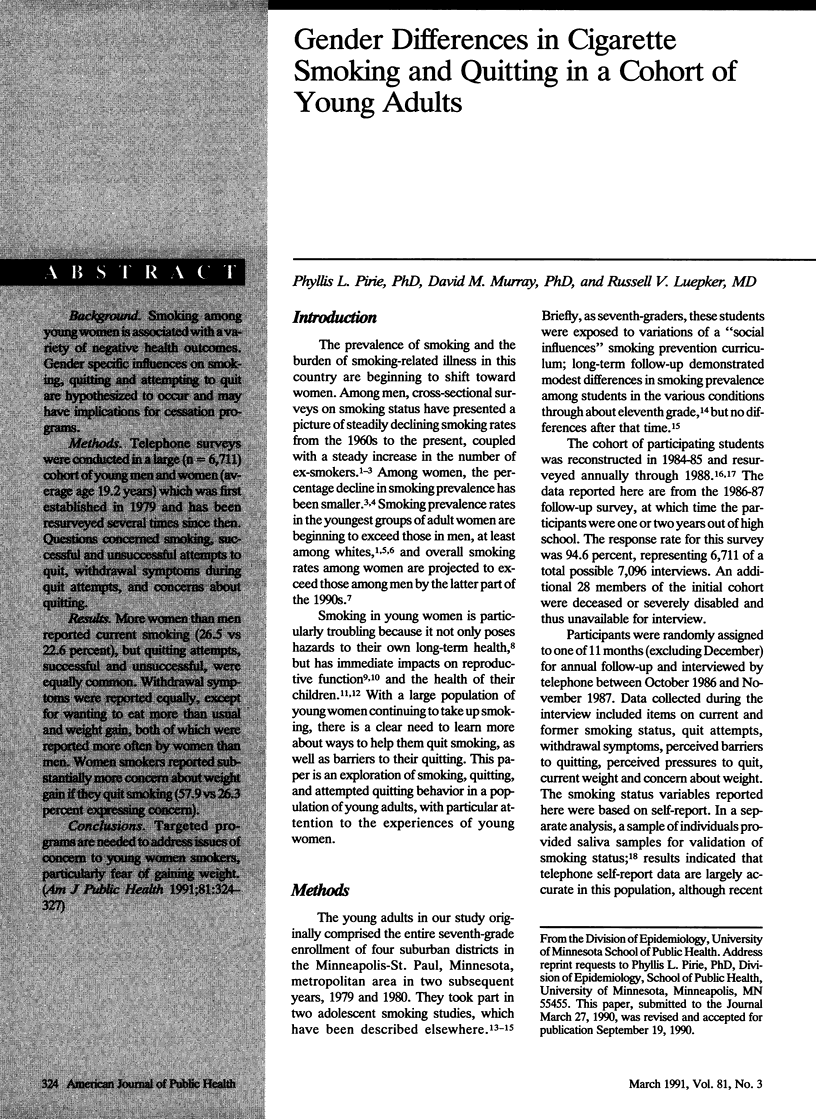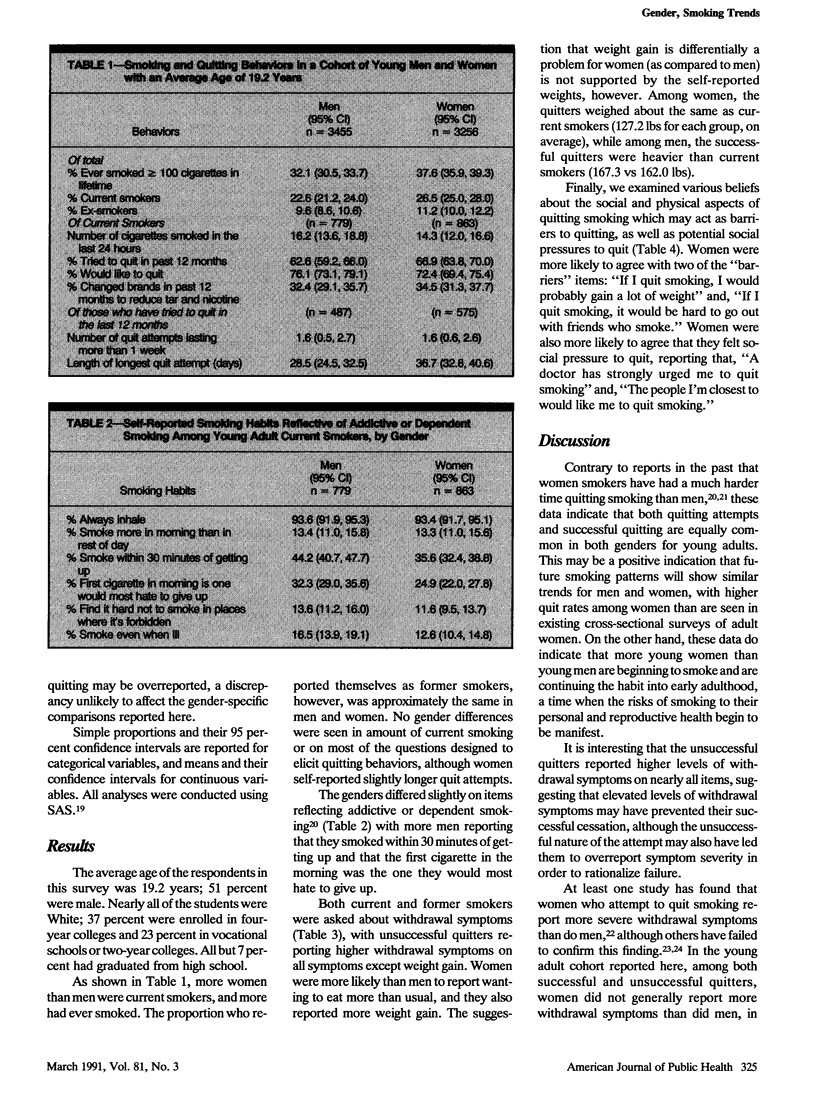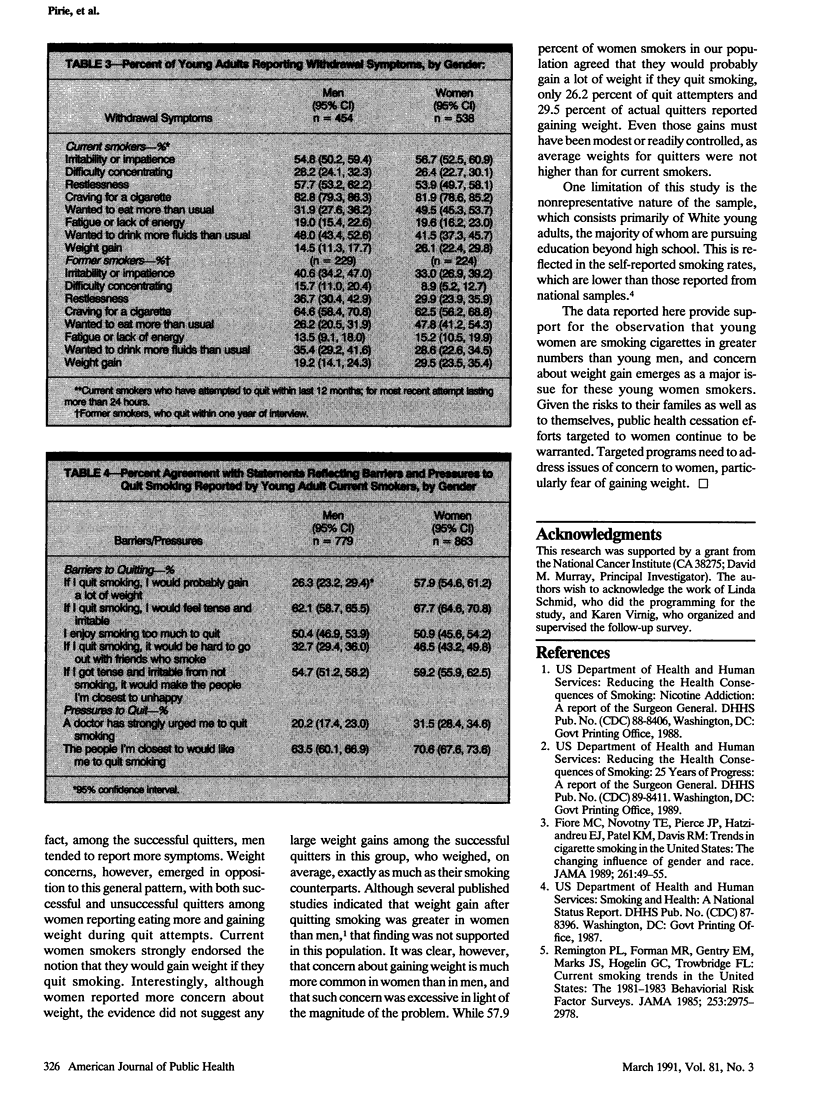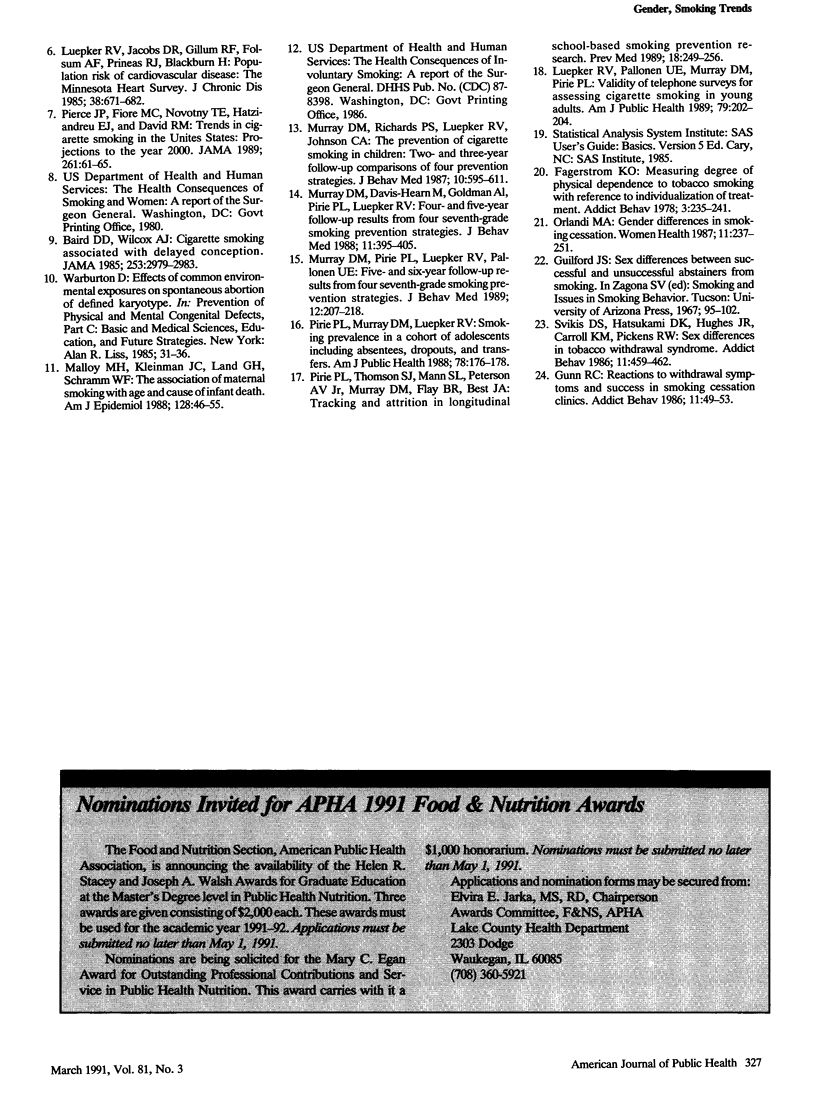Abstract
BACKGROUND. Smoking among young women is associated with a variety of negative health outcomes. Gender specific influences on smoking, quitting and attempting to quit are hypothesized to occur and may have implications for cessation programs. METHODS. Telephone surveys were conducted in a large (n = 6,711) cohort of young men and women (average age 19.2 years) which was first established in 1979 and has been resurveyed several times since then. Questions concerned smoking, successful and unsuccessful attempts to quit, withdrawal symptoms during quit attempts, and concerns about quitting. RESULTS. More women than men reported current smoking (26.5 vs 22.6 percent), but quitting attempts, successful and unsuccessful, were equally common. Withdrawal symptoms were reported equally, except for wanting to eat more than usual and weight gain, both of which were reported more often by women than men. Women smokers reported substantially more concern about weight gain if they quit smoking (57.9 vs 26.3 percent expressing concern). CONCLUSIONS. Targeted programs are needed to address issues of concern to young women smokers, particularly fear of gaining weight.
Full text
PDF



Selected References
These references are in PubMed. This may not be the complete list of references from this article.
- Baird D. D., Wilcox A. J. Cigarette smoking associated with delayed conception. JAMA. 1985 May 24;253(20):2979–2983. [PubMed] [Google Scholar]
- Fagerström K. O. Measuring degree of physical dependence to tobacco smoking with reference to individualization of treatment. Addict Behav. 1978;3(3-4):235–241. doi: 10.1016/0306-4603(78)90024-2. [DOI] [PubMed] [Google Scholar]
- Fiore M. C., Novotny T. E., Pierce J. P., Hatziandreu E. J., Patel K. M., Davis R. M. Trends in cigarette smoking in the United States. The changing influence of gender and race. JAMA. 1989 Jan 6;261(1):49–55. [PubMed] [Google Scholar]
- Gunn R. C. Reactions to withdrawal symptoms and success in smoking cessation clinics. Addict Behav. 1986;11(1):49–53. doi: 10.1016/0306-4603(86)90008-0. [DOI] [PubMed] [Google Scholar]
- Luepker R. V., Jacobs D. R., Gillum R. F., Folsom A. R., Prineas R. J., Blackburn H. Population risk of cardiovascular disease: the Minnesota Heart Survey. J Chronic Dis. 1985;38(8):671–682. doi: 10.1016/0021-9681(85)90021-9. [DOI] [PubMed] [Google Scholar]
- Luepker R. V., Pallonen U. E., Murray D. M., Pirie P. L. Validity of telephone surveys in assessing cigarette smoking in young adults. Am J Public Health. 1989 Feb;79(2):202–204. doi: 10.2105/ajph.79.2.202. [DOI] [PMC free article] [PubMed] [Google Scholar]
- Malloy M. H., Kleinman J. C., Land G. H., Schramm W. F. The association of maternal smoking with age and cause of infant death. Am J Epidemiol. 1988 Jul;128(1):46–55. doi: 10.1093/oxfordjournals.aje.a114957. [DOI] [PubMed] [Google Scholar]
- Murray D. M., Davis-Hearn M., Goldman A. I., Pirie P., Luepker R. V. Four- and five-year follow-up results from four seventh-grade smoking prevention strategies. J Behav Med. 1988 Aug;11(4):395–405. doi: 10.1007/BF00844938. [DOI] [PubMed] [Google Scholar]
- Murray D. M., Pirie P., Leupker R. V., Pallonen U. Five- and six-year follow-up results from four seventh-grade smoking prevention strategies. J Behav Med. 1989 Apr;12(2):207–218. doi: 10.1007/BF00846551. [DOI] [PubMed] [Google Scholar]
- Murray D. M., Richards P. S., Luepker R. V., Johnson C. A. The prevention of cigarette smoking in children: two- and three-year follow-up comparisons of four prevention strategies. J Behav Med. 1987 Dec;10(6):595–611. doi: 10.1007/BF00846657. [DOI] [PubMed] [Google Scholar]
- Orlandi M. A. Gender differences in smoking cessation. Women Health. 1986 Fall-Winter;11(3-4):237–251. doi: 10.1300/j013v11n03_16. [DOI] [PubMed] [Google Scholar]
- Pierce J. P., Fiore M. C., Novotny T. E., Hatziandreu E. J., Davis R. M. Trends in cigarette smoking in the United States. Projections to the year 2000. JAMA. 1989 Jan 6;261(1):61–65. [PubMed] [Google Scholar]
- Pirie P. L., Murray D. M., Luepker R. V. Smoking prevalence in a cohort of adolescents, including absentees, dropouts, and transfers. Am J Public Health. 1988 Feb;78(2):176–178. doi: 10.2105/ajph.78.2.176. [DOI] [PMC free article] [PubMed] [Google Scholar]
- Pirie P. L., Thomson S. J., Mann S. L., Peterson A. V., Jr, Murray D. M., Flay B. R., Best J. A. Tracking and attrition in longitudinal school-based smoking prevention research. Prev Med. 1989 Mar;18(2):249–256. doi: 10.1016/0091-7435(89)90072-8. [DOI] [PubMed] [Google Scholar]
- Remington P. L., Forman M. R., Gentry E. M., Marks J. S., Hogelin G. C., Trowbridge F. L. Current smoking trends in the United States. The 1981-1983 behavioral risk factor surveys. JAMA. 1985 May 24;253(20):2975–2978. [PubMed] [Google Scholar]
- Svikis D. S., Hatsukami D. K., Hughes J. R., Carroll K. M., Pickens R. W. Sex differences in tobacco withdrawal syndrome. Addict Behav. 1986;11(4):459–462. doi: 10.1016/0306-4603(86)90028-6. [DOI] [PubMed] [Google Scholar]


